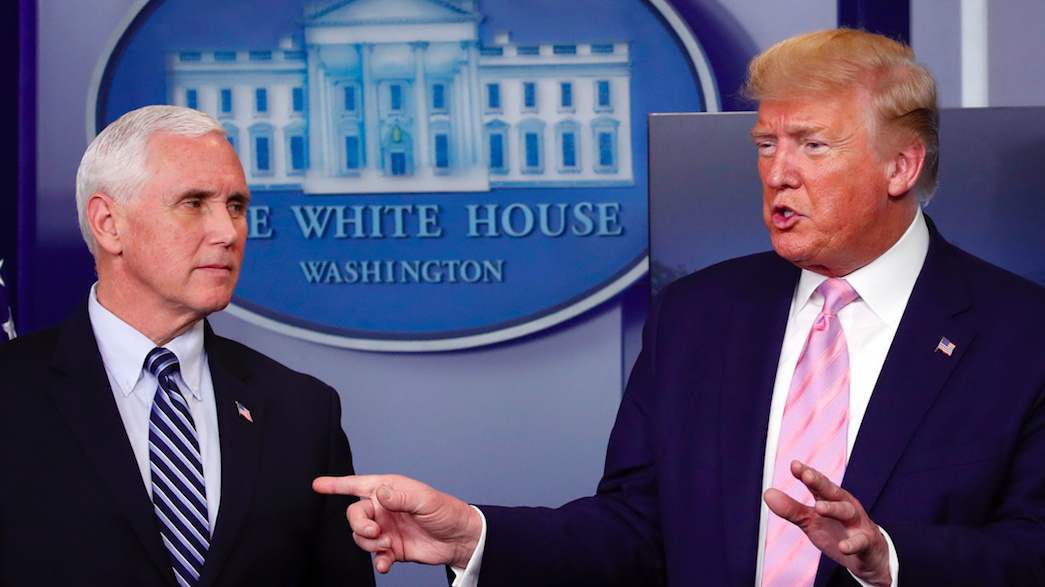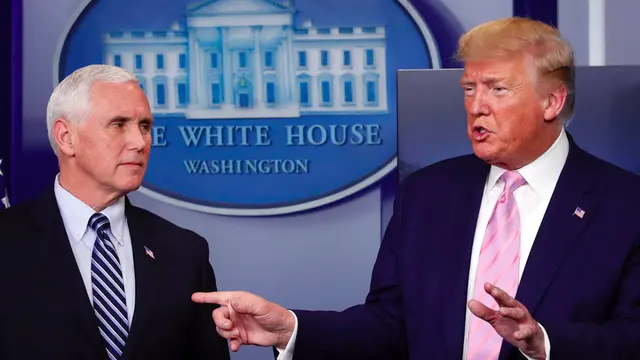
U.S. President Donald Trump speaks about the coronavirus in the James Brady Press Briefing Room of the White House in Washington DC, as Vice President Mike Pence listens. April 1, 2020. /AP
Editor's note: Mustafa Hyder Sayed is the executive director of the Pakistan-China Institute. The article reflects the author's opinions and not necessarily the views of CGTN.
As the world combats the COVID-19 pandemic and its grueling effects on economy and employment, we see a finger-pointing, accusatory approach as opposed to a problem-solving one from the international community.
U.S. President Trump recently announced that he had seen evidence that the COVID-19 had been created out of a lab in Wuhan, the city where the virus originally emerged. Interestingly, the U.S. national intelligence director's office said that it had determined that the virus was "not man-made or genetically modified", challenging the Trump's assertion.
Trump's accusatory tone has also been echoed by the likes of the Australian foreign minister as well as the German government who have called for what seems to be a China-specific inquiry on the spread of the virus and claimed damages from the Chinese government, respectively.
At a time when experts are comparing this to the greatest international crisis and subsequent impending economic depression, international cooperation and solidarity are a prerequisite for the world to demonstrate collective resilience and strength.
To contextualize and better understand the upping of the ante against China, we must ask ourselves the following questions: 1) Is the targeting of China (so far without any data or evidence) driven by emotion or reason? 2) Does it really serve U.S. national interest to accuse China of creating the COVID-19 pandemic in a laboratory in Wuhan? 3) Has China benefited at the cost of other countries by the COVID-19 pandemic that gives us cause to believe conspiracy theories? 4) Is scapegoating China a political requirement for the domestic audiences of some Western countries?
Visitors wearing face masks to protect against the new coronavirus pose for a selfie in the Forbidden City in Beijing, China, May 1, 2020. /AP
The answers to the above questions may not be unequivocal but there are few things which are clear. Even pre-COVID-19, the U.S. was grappling as how to challenge and stunt the economic growth of a rising China, whom many in Washington argued, was at the cost of the U.S. economy and American jobs.
Ishan Tharoor, in his April 28 article for the Washington Post, "The world doesn't want to pick between the U.S. and China", argues that while U.S.-China cooperation to fight the pandemic are vital as opposed to choosing the U.S. over China or vice versa.
In Washington, the space to accommodate and co-exist with another economic (and perhaps military) equal does not have many takers – and the COVID-19 outbreak coupled with the upcoming U.S. election has given renewed impetus and bipartisan support to taking on China.
On April 24, Politico, a popular U.S.-politics magazine reported that a 57-page strategy document was given by the National Republican Senatorial Committee to all its candidates.
The document contained three major messages that Republican candidates were asked to repeat and emphasize: 1) that China caused the COVID-19 pandemic "by covering it up", 2) that the Democrats are "soft on China", and 3) that Republicans will "push for sanctions on China for its role in spreading the pandemic".
In the September 1997 issue of the Foreign Affairs magazine, Samuel Huntington, in an article titled Erosion of American National Interests, argues that U.S. foreign policy has always been cultivated against an enemy, and that the need for an adversary for the U.S. has always been there, to help achieve and justify its ambitious foreign policy goals.
He also argues that "Americans have constructed their creedal identity in contrast to an undesirable 'other'. America's opponents are always described as liberty's opponents".
After Soviet Russia and Islamic Fundamentalism, a notion of a new adversary is being cultivated in Washington: China. However, there is a stark contrast with Cold War-era Soviet Union and today's China.
Kishore Mahbubani, in his new book, "Has China Won", poses an important question: "With 4 percent of the world's population, America's share of the global GDP was close to 50 percent at the end of World War II. Throughout the Cold War, the GDP of the Soviet Union never came close to that of America, reaching only 40 percent that of America at its peak. Could America's GDP become smaller than China's in the next thirty years? If so, what strategic changes will America have to make when it no longer is the world's dominant economic power?"
While it is politically expedient to find an adversary in China, it would serve the U.S. well to have a compelling and well-thought-out strategy of how to engage with China. At the moment, a comprehensive, long-term strategy seems absent, and a fire-fighting approach seems to be the substitute.
(If you want to contribute and have specific expertise, please contact us at [email protected].)
 简体中文
简体中文

